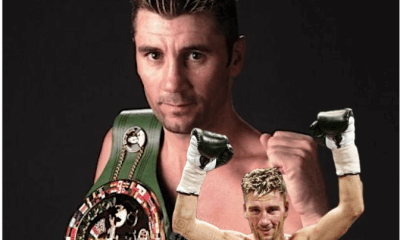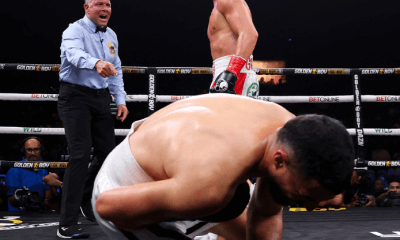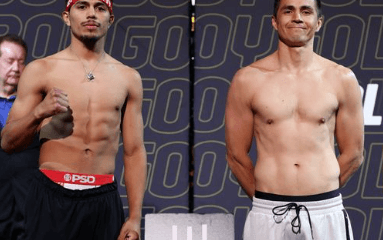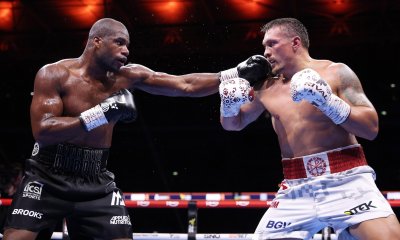Featured Articles
Berlanga’s KO1 Streak Looking More Like Valero’s Than Brunson’s
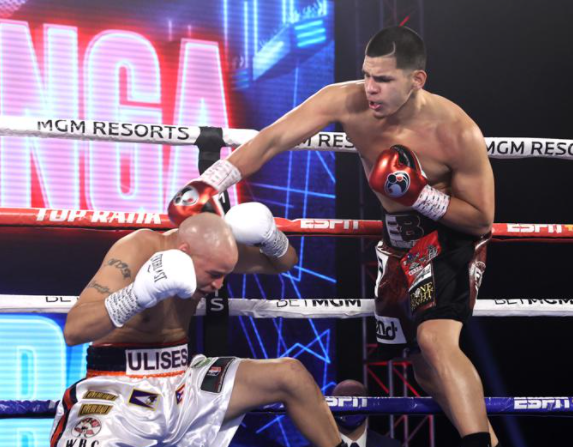
It isn’t exactly a news flash that most fight fans are mesmerized by power-punchers, maybe even more than usual if a particular knockout artist has demonstrated an affinity for swift, percussive put-aways. That being the case, it well could be that super middleweight Edgar Berlanga’s scheduled eight-rounder with Demond Nicholson, supposedly the co-feature in support of WBO featherweight champion Emanuel Navarrete’s defense against Christopher Diaz Saturday night in Kissimmee, Fla., will be more scrutinized than the main event.
Those bouts will be televised by ESPN/ESPN+.
Nicknamed the “Chosen One,” the Brooklyn-born Berlanga, who turns 24 on May 18, has won all 16 of his professional bouts on first-round knockouts. If he can extend his streak of never having had to answer the bell for the second round, hardly a gimme given that Nicholson (23-3-1, 20 KOs) arguably poses his sternest test to date, Berlanga’s bandwagon, which is already taking on lots of riders, is apt to soon become standing-room-only.
“When we say the phrase `heavy hands,’ Exhibit A is Edgar Berlanga,” ESPN blow-by-blow commentator Joe Tessitore said after Berlanga, who is of Puerto Rican descent and hopes to follow in the footsteps of his island idols, Felix Trinidad and Miguel Cotto, rang up No. 16 with a swift stoppage of another credible opponent, Ulises Sierra, on Dec. 20 at Las Vegas’ MGM Grand.
Some records are less legitimate than others, and such would appear to be the case with Yemeni flyweight Ali Raymi’s mark of 21 one-round KOs at the outset of his career. Although Raymi, whose last bout was in 2015, won each of his 25 pro fights inside the distance, they all took place in his home country and against less-than-stellar competition. Also highly suspect is Tyrone Brunson’s next-best mark of 19 consecutive one-round KOs. The still-active Brunson, a Philadelphian who has fought as a junior middleweight, middleweight and super middleweight, technically defeated five undefeated opponents during his KO1 run, but all five of those victims were making their pro debuts and four of them never fought again. Now 28-8-2 with 25 KOs, Brunson is just 9-8-2 with six wins and five losses by KO since his opening spree of quickies.
In a story I authored for The Sweet Science on April 16, 2015, titled When the Grandmothers Stopped Falling for Tyson Brunson, Brunson’s then-promoter, Carlos Linas, explained why and how the bogus record was orchestrated.
“Even if you fought 19 grandmothers in a row, it’s still kind of notable to get all of them out of there in the first round,” Linas rationalized.
“Look, I know Tyrone has been moved slow. There have been bumps along the way. But we’re on the way now. I’ve seen him spar with guys like Kassim Ouma, Ronald Hearns (Tommy’s son), Kermit Citron and Andy Lee, and more often than not he walks through them. I saw him flatten Hearns in the gym.
“In retrospect, maybe it was a mistake to bring Tyrone along so slow. I tried to do what’s best. It (the one-round KO streak) was kind of an angle that we all came up with and tried to achieve. We believed in Tyrone’s talent, and still do, but perhaps we should have groomed him better along the way. I guess we’re still trying to reinvent the wheel. It didn’t work out. As he stepped up in competition, things got a little tough.”
For more than a century, the accepted record for one-round knockouts at the start of a pro career was held by Arthur Susskind, who, billed as Young Otto, strung together 16 such wins, a run that ended in 1905. By all accounts, Young Otto was a better than decent puncher, with 44 first-round KOs reportedly to his credit. But his record would be eclipsed by an even more devastating force of nature, Venezuelan southpaw Edwin Valero, a two-division world champion who won all 27 of his pro bouts by knockout, the first 18 in the opening round.
The WBA super featherweight and then WBC lightweight ruler, Valero, who was 28 when he committed suicide on April 19, 2010, a day after he was arrested on suspicion of murdering his wife, likely would have been inducted into the International Boxing Hall of Fame were it not for the unwelcome notoriety that attached itself to him while he was still an active fighter. Less than two weeks before his wife’s death and his subsequent taking of his own life (using his pants for a noose, he hung himself in his jail cell the day after his arrest), Valero had vacated his WBC lightweight title in expectation of moving up to junior welterweight and a bid for a championship in a third weight class.
What, you say long-reigning middleweight champion and Argentine legend Carlos Monzon is enshrined in the IBHOF and was actually convicted of murdering his second wife? Monzon, 52 when he died in a car crash while on furlough from prison, was a member of the IBHOF’s charter class of inductees in 1990. It might seem that the heavy out-of-the-ring baggage carried by Monzon was at least similar to Valero’s, but to date El Inca Dinamita has never appeared on the ballot.
Whether or not he ever will be officially immortalized with a plaque in Canastota, N.Y., several of those who saw Valero in action believe he would not only be competitive with a likely future Hall of Famer, he’d have won.
Eric Gomez, president of Golden Boy Promotions (for whom Valero fought from the mid-point of his career on), picked him to defeat Vasiliy Lomachenko in a speculative story I did for TSS, Fantasy Fisticuffs: The Late Edwin Valero vs. Vasyl Lomachenko. Who Wins?, which was posted on Jan. 9, 2018.
“Oh, it wouldn’t be that competitive a fight,” Gomez said. “Valero would knock Lomachenko out. Valero was a truly special fighter, a special talent. He was very, very strong. He had raw power, incredible power, and in both hands. If he hit you, you were out of there, and he hit everybody. Every fight a win, every fight a knockout.”
So, with apologies to Raymi and Brunson, let’s set the unofficial but more palatable record for one-round knockouts out of the gate to Valero. Should Berlanga make Nicholson the 17th addition to his collection, he’d need just one more blitz to match a standard that seemingly would earn anyone’s seal of approval. During his 18-fight equivalents of a speedway drag race, Valero’s victims were a collective 155-102-17 going into their matchups with him, with 77 KO wins and 53 such losses. Berlanga’s comparative mark as of now stands at 166-67-12, with the vanquished compiling 89 KO victories to just 25 defeats.
It should be interesting to see whether Berlanga feels any pressure to throw everything he has at Nicholson from the jump. But even if he has to satisfy himself with a somewhat delayed win by stoppage, or even a triumph on points, the drum beat of support for him is likely to grow louder if he continues to be a source of explosive power in a sport that dotes on such displays.
If Berlanga again does his thing in the manner to which he and his supporters have become accustomed, Navarrete (33-1, 28 KOs) and Diaz (26-2, 16 KOs) might find they have a tough act to follow.
Photo credit: Mikey Williams for Top Rank via Getty Images
Check out more boxing news on video at the Boxing Channel
To comment on this story in the Fight Forum CLICK HERE
-

 Featured Articles2 weeks ago
Featured Articles2 weeks agoResults and Recaps from New York Where Taylor Edged Serrano Once Again
-

 Featured Articles2 weeks ago
Featured Articles2 weeks agoResults and Recaps from NYC where Hamzah Sheeraz was Spectacular
-

 Featured Articles3 weeks ago
Featured Articles3 weeks agoFrom a Sympathetic Figure to a Pariah: The Travails of Julio Cesar Chavez Jr
-

 Featured Articles2 weeks ago
Featured Articles2 weeks agoPhiladelphia Welterweight Gil Turner, a Phenom, Now Rests in an Unmarked Grave
-

 Featured Articles7 days ago
Featured Articles7 days agoManny Pacquiao and Mario Barrios Fight to a Draw; Fundora stops Tim Tszyu
-

 Featured Articles3 weeks ago
Featured Articles3 weeks agoCatterall vs Eubank Ends Prematurely; Catterall Wins a Technical Decision
-

 Featured Articles5 days ago
Featured Articles5 days agoArne’s Almanac: Pacquiao-Barrios Redux
-
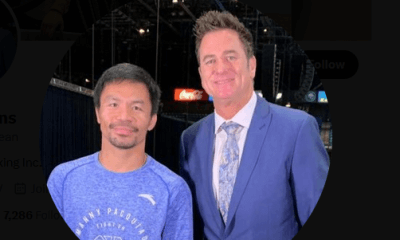
 Featured Articles2 weeks ago
Featured Articles2 weeks agoFrom the Boondocks to the Big Time, The Wild Saga of Manny Pacquiao’s Sidekick Sean Gibbons


